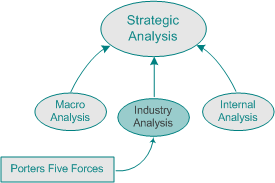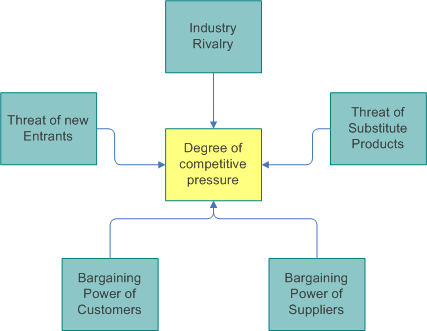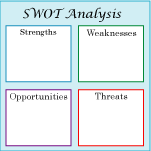Porters Five Forces - Competitive Analysis
Content rich web pages, including free porters five forces template available in PDF or MS Word. Plus handy hints and tips for leaders.
"Discover everything you will ever need to know about Porter's Competitive Analysis!"
Porters Five Forces Context
Generally, strategic planning commences with an analysis phase, where you seek to refresh your understanding of your businesses 3 key strategic environments, these three strategic enviroments that you analyse during your strategic analysis are your
- Macro Environment,
- Industry Environment, (or Porter's Five Forces), and
- Internal Environment
Porters five forces is a competitive analysis model, it helps you to understand at the nature of competition within your industry, hence it is used when completing your industry analysis.

Porter’s model provides a good, simple yet powerful, framework for developing an understanding of the competitive forces in your industry.
Get Your Free Porters Five Forces Template Here! Now available in PDF or MS Word!
Discovering the Five Forces
Michael Porter developed a framework, which identified 5 forces that act to either increase or reduce the competitive forces within an industry. These five forces are
- The Bargaining Power of Your Customers
- The Threat of New Entrants into your Industry
- The Bargaining Power of Suppliers
- Threat of Substitute Products or Services
- Rivalry Amongst Existing Firms
In general terms, the greater the competitive forces in your industry the more pressure you are likely to find on your prices. Whereas, the weaker the competitive forces in your industry the less pressure you are likely to have on your prices.

Note:
Porters Five Forces – Overview of Each Force
By completing a competitive analysis you are becomming informed on who has the bargaining power before you commence negotiations with your customers and suppliers. Being informed ensues that your negotiations are less influenced by the skill of the negotiator and more by your commercial reality.
Now lets look at each of these five forces in more detail.
The Bargaining Power of Your Customers
When analyzing the power of your customers you are really determining who needs who the most. This is driven, in part, by the number of prospective customers compared to the number of suppliers (suppliers are your competitors).
A strong or powerful customer can play you off against your competitors. Your strong customers may ask for higher quality or improved service at the same price or simply, for a lower price. Where a less strong customer may simply try to bluff you.
In general
- The greater the number of customers to your inductry the less commercial power any one customer will have
- The greater the number of competitors you have the greater your customers negotiating power
However, other factors such as the significance of the customer to you or their ability to switch to your competitors also plays a part in determining who has the power.
To learn more about the bargaining power of your customers including the top 11 things to consider during your analysis, click here, you will also find out how to apply each of these 11 points of analysis to your industry and you will learn from the many examples provided. (When finished use your browser back button to return to this page)
The Threat of New Entrants to Your Industry
A new entrant to your industry is a brand new competitor or maybe a new brand from on old competitor.
A new competitor to your industry may erode some of your customer base, your challenge is to determine if it is likely that a new competitor will come along and try to steal your customers away.
New competitors are restricted by up front capital costs, access to technology or requirements to obtain licenses then your market position is likely to be protected. However, if there are no barriers to entry your position could be weakened.
Tip: Sometimes a new competitor in your area is a good thing. For example if you own a craft shop and four more craft shops open near you, the collective scale of the five craft shops may attract significantly more people to the area resulting in growth of your business.
You need to determine if a new entrant is a good or a bad thing for your business.
Find out more about the threat of new entrants Click here and get your free how to guide and free analysis template!
The Bargaining Power of Your Suppliers
The bargaining power of your suppliers is like the bargaining power of customers only in reverse, you are now the customer, where before you were the supplier.
How dependant on your business is your supplier, or are you dependant on your supplier? How much power does your suppliers have? Can they raise prices or reduce service without the fear of losing your business?
In general terms the fewer suppliers that you have to choose from the less power you have to negotiate. Other factors such as the cost to switch suppliers also plays a part in determine who has the power.
You will find that a supplier with a unique product that contributes to the uniqueness of your product has a lot of negotiating power, unless they too are dependant on you.
Note: The more powerful the suppliers to an industry, the less profitable the industry tends to be.
Learn how to complete an analysis of the power of suppliers to your industry, click here for your detailed free how to guide and free analysis template!
The Threat of Substitute Products or Services
A substitute product is a product that replaces the need for your product altogether.
One example, Timber is the main component of house frames. However, more and more steel frames are being produced. From a timber mills perspective, steel is a substitute for timber in house frames.
Are your customers likely to find an alternative product or service to use instead of your product or service? Will substitute products or services erode your profits?
To find out more about the threat of substitute products and services to your industry click here for your free how to guide and free template!
Rivalry Amongst Existing Firms
In many industries most marketing is aimed at maintaining market share, especially when looking at fast moving consumer goods. The industry becomes stable and changes in market share tend to be slow.
However, are any of your competitors thinking about growing their business? If so will you loose business? Will they steal your customers away?
Some of the tactics that your competitors may use to compete for market position are
- Reduced prices or increased price competition
- Increased advertising
- Differentiating based on customer service
- or, many other techniques
Learn how to assess the rivalry amongst existing firms in your industry, click here for your how to guide and free template.
Further Reading
For further details on each of the five forces, use the links below to navigate you to more content rich pages.
- The Bargaining Power of Your Customers
- The Threat of New Entrants into your Industry
- The Bargaining Power of Suppliers
- Threat of Substitute Products or Services
- Rivalry Amongst Existing Firms
Porters Five Forces - Competitive Analysis Wrap Up
Porters five forces is an analysis model that is widely used when completing a competitive analysis of your industry. Each of the five identified forces acts to increase or reduce the nature of competition in an industry.
The greater the competition in an industry the lower the likely profits in that industry.
Don’t forget to get your MS Word free Porters Five Forces template including sample questions that will help guide your analysis, or for PDF Click Here
Thank you for visiting



